Alwaght- The American strategy of East Asia revolves in general around two principles: boosting economic, military, and political presence on the one hand and supporting the allies in the face of a rising China on the other hand.
During the past three decades, the countries of East Asia have experienced exemplary and comprehensive growth economically, militarily, socially, and culturally. For instance, the average growth rate of per capita GDP of China and other big East Asian economies like Indonesia, South Korea, Malaysia, Philippines, Hong Kong, Thailand, and Singapore in the past 30 years has been 4 percent, in comparison to the 2.6 percent of the developed countries and the 2 percent of the developing countries.
The East Asia is the only region of the world whose living standards according to the valid international rating agencies are getting closer to those of the developed Western countries, contrary to other parts of the world whose standards are distancing far away from the ideals.
However, like other parts of the world, East Asia is not free from conflicts and tensions as its countries' rifts predominantly have their roots in historical, economic, territorial, and geopolitical disputes.
The historical rows mainly sparked after royal Japan's occupation of large parts of China and South Korea during the First and Second World Wars. Beijing and Seoul officials still accuse Tokyo of war crimes against their people. These accusations every now and then cause heated debates and lead to frayed diplomatic relations with Japan.
From an economic aspect, the thriving economic growth of China during the past three decades changed regional trade balance in favor of Beijing as value and volume of its exports kept jumping up. The Chinese companies in various sectors like car manufacturing, construction, and rail transportation over time overtook once-superior Japanese companies and made the competition climate resoundingly tough for them. Presently, the Chinese trade surplus in its foreign dealings sets off the alarm bells for other countries.
Furthermore, when it comes to the territorial disputes, the regional countries have a long history. A series of countries like China, Vietnam, Indonesia, Japan, and Philippines each are laying overlapping claims to a chain of small and big islands in South China Sea, not to mention the gradually warming dispute over East China Sea's Senkaku Islands. The energy reserves, trade and shipping significance, and strategic military position that provide the dominant country with the power to control the international seaways are the overarching factors inflaming the row over which country should hold these sporadic islands.
These strategic disputes in recent years set up the foundation for regional and international alliances. Various powers work together under alliances to make sure they can take on the opposite side in a fierce rivalry. China for example established friendly relations with Pakistan, connected the two countries' trade lines through North-South Transport Corridor, heavily invested in the Pakistani ports, and most importantly strengthened Beijing-Islamabad military cooperation through staging joint military drills. The same is being done by Japan with India as the two countries bolster joint work in more than one area, indicating that Tokyo is well resolved to engage in a regional race with China.
North Korea crisis, which is represented by Pyongyang's development of long-range ballistic missiles and also pressing ahead with its nuclear program, is independently the main challenge overshadowing the peace in East Asia. Analysts suggest that North Korea crisis is a perfect embodiment of the East Asian disputes. The US builds its strategy on the North Korea crisis that is the main pretext for the Americans to be present militarily in the region and to take provocative steps to keep the crisis heated enough for their continued presence. Nevertheless, there is a superior objective for the US military presence in the region, much more crucial than providing the regional allies with deterrence against North Korea. Under the excuse of allies' protection against Pyongyang’s ballistic missiles threats, which are largely stimulated by the US military amassment on its borders, Washington has been going to great lengths to contain China and its increasing regional sway.
One of the core tenets of the US policy is preventing regional powers' rise that can tip the scales of power against Washington’s favor. Under this policy, apparently known “dual containment,” the US seeks pushing up one regional country in the face of regional powers and shaping a balance between them by helping the allied side in a variety of areas.
Currently, China is a rising East Asian power that garners potentials to transform to a global superpower. According to the World Bank reports, three decades of fast growth now is turning the Chinese economy into nearly the biggest world economy as the purchasing power parity per capita statistics and other indicators show. The economic performance data also suggest that China already equals to the US in many technological and industrial areas.
China’s naval strength is another symbol of this ancient power that historically and just before the time of European colonization in East Asia was a big brother to the regional nations. Before Europeans’ domination of the world economy and trade, China had the biggest economy by GDP standards, and now the history repeats itself.
China is rising again, raising the hackles of the US that has long been obsessed with West Asia and Eastern Europe. This gave Washington enough resolution over past decade to work out a policy to curb Beijing, something that was reflected in former President Barack Obama's “pivot to Asia” strategy. Such a strategy took the US to back China’s neighbors Japan and South Korea, strengthen and arm such regional countries as Vietnam and Taiwan, and even provoke others against the Chinese interests.



























